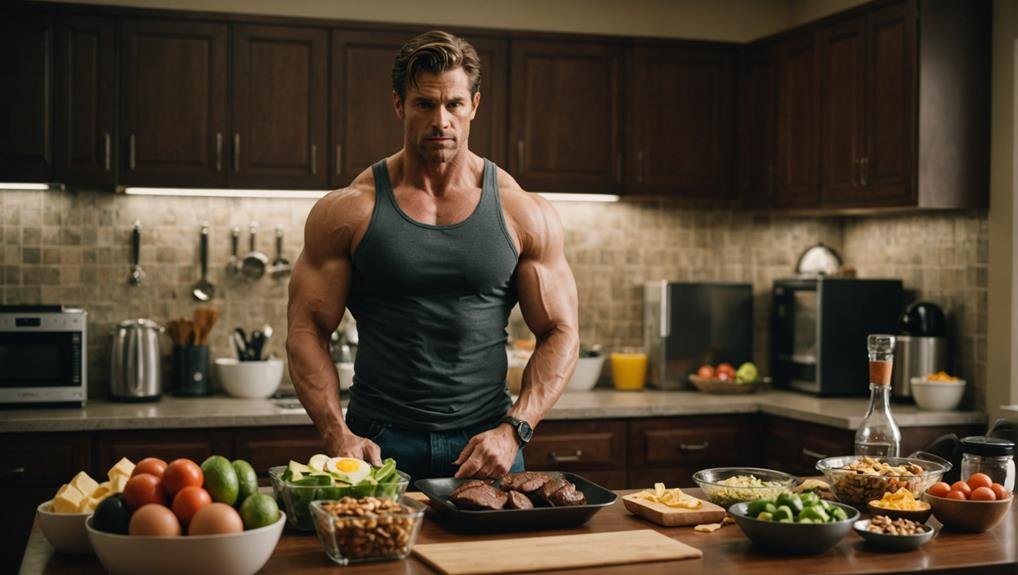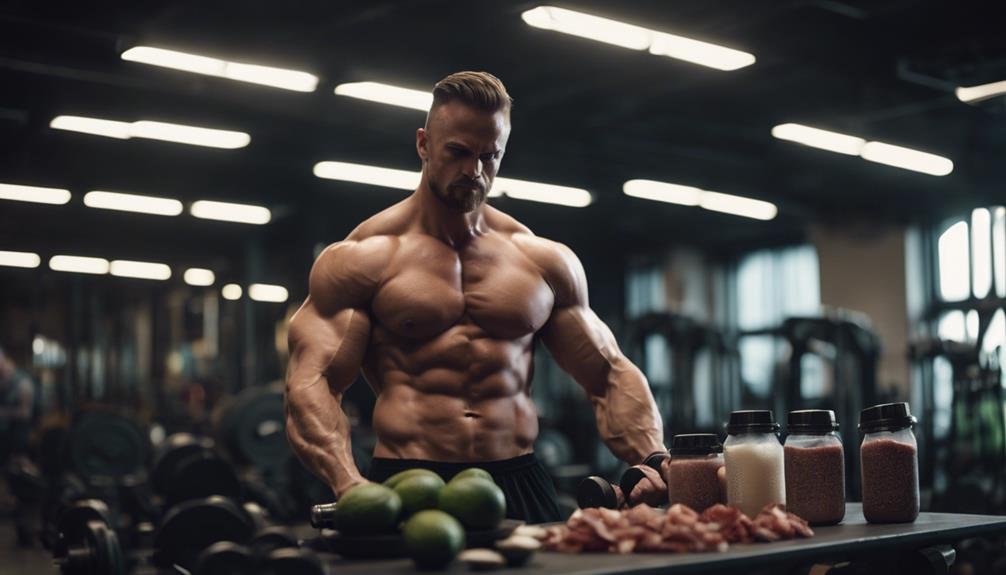The ancient Greek ideal of physical perfection, ‘a sound mind in a sound body,’ remains a timeless aspiration.
As a bodybuilder, you’re likely exploring alternative fuel sources to optimize your physique. The ketogenic diet, with its drastic carb reduction, induces a state of ketosis, where the body burns fat for energy.
However, the question remains: can you achieve substantial muscle mass without carbohydrates?
To succeed, you must understand the optimal balance of macronutrients for muscle growth, which demands precision and patience.
Key Takeaways
To optimize muscle growth on a ketogenic diet, follow these guidelines:
- Consume 1.4-2g protein/kg body weight daily, spread over 3-5 meals to support muscle growth and maintenance.
- Ensure a caloric surplus by balancing fat and carbohydrate intake, prioritizing whole foods like meats, fish, eggs, avocados, and olive oil, while limiting carbohydrates to 5% to maintain ketosis.
- Implement a high-intensity strength training program with progressive overload to stimulate muscle growth and development.
- Regularly monitor ketone levels to ensure sustained ketosis and adjust diet and training accordingly to optimize muscle growth and body composition.
Building muscle on keto
To build muscle on a keto diet, strike a balance between macronutrient intake and strength training to achieve a state of ketosis that supports muscle growth. This requires careful planning to ensure you’re consuming the right amount of protein, healthy fats, and calories per day.
Aim to consume 1.4-2g of protein per kilogram of body weight daily, spread across 3-5 meals, to support muscle gain. Ensure a caloric surplus to support muscle growth, but avoid overdoing it, as this can lead to fat gain. Focus on whole, nutrient-dense foods like meats, fish, eggs, and healthy fats like avocados and olive oil. Avoid processed and high-carb foods that can disrupt ketosis.
Consistent strength training with progressive overload is crucial for building muscle on a ketogenic diet. Train each major muscle group 3-4 times per week, and incorporate compound exercises like squats, deadlifts, and bench presses. Monitor ketone levels regularly to ensure you’re staying in a state of ketosis.
Do you build muscle faster on keto?
Building muscle on a keto diet is possible, but its superiority over other diets in terms of speed is unproven.
To build muscle, you need to consume sufficient protein (1.4-2 grams per kilogram of body weight daily) and maintain a calorie surplus. A keto diet’s high-fat content may be beneficial for muscle growth, but its restrictive nature can make it challenging to maintain a calorie surplus.
Successful muscle building on a keto diet requires careful macronutrient planning. While it may not be faster than other diets, a keto diet can still support muscle growth with proper nutrition and dedication.
How to eat keto for bodybuilding

To fuel your bodybuilding goals on a keto diet, prioritize protein intake, moderate fat consumption, and low-carb eating.
Determine your individual protein needs, typically 1.4-2 grams of protein per kilogram of body weight daily. For a 60-kilogram person, aim for 84-120 grams of protein.
To support muscle growth, ensure a sufficient caloric surplus with a specific proportion of fat and carbs daily, while maintaining overall calories that enable muscle growth without storing body fat.
Balance training and nutrition by setting objectives for your weekly exercise, incorporating high-level strength training and progressive overload elements to sustain muscle protein and gain muscle.
Ensure daily calories are sufficient to support muscle growth without promoting unwanted body fat formation. This approach can also help with losing body fat while maintaining muscle mass through weight training exercises.
Keto bodybuilding results
Combining a ketogenic diet with bodybuilding principles can lead to significant improvements in body composition, with reported simultaneous fat loss and muscle gain. Balancing macronutrient intake, particularly protein, is crucial to support muscle growth while maintaining a caloric surplus.
When following a keto bodybuilding regimen, noticeable improvements in body composition can be expected within a few weeks. The expected results include:
| Timeframe | Expected Results |
|---|---|
| 2-4 weeks | Fat loss, especially in the abdominal area |
| 6-8 weeks | Increased muscle mass and strength gains |
| 10-12 weeks | Improved muscle definition and toning |
| 14-16 weeks | Enhanced athletic performance and endurance |
| 18-20 weeks | Significant increases in muscle mass and strength |
To achieve these results, prioritize protein intake, aiming for 1.4-2g/kg body weight daily to support muscle growth and maintenance. Ensure a caloric surplus of 250-500 calories above maintenance level to support muscle growth. Additionally, consider tracking progress through measurements, weight, and body fat percentage to adjust macronutrient intake and training protocols as needed.
Best keto diet for building muscle

To craft a keto diet that supports muscle growth and maintenance, prioritize a well-structured macronutrient balance.
For building muscle on keto, aim for 1.4-2g/kg body weight of protein daily, focusing on protein-rich foods like meats, fish, and eggs. Additionally, emphasize healthy fats like avocados, olive oil, and nuts.
Limit carbohydrate intake to around 5% of daily calories, cutting out sugary drinks, grains, and starchy vegetables. Instead, focus on leafy greens, broccoli, and other low-carb vegetables. This will enable you to maintain ketosis, which is essential for burning fat and building muscle.
A well-structured ketogenic diet provides the necessary building blocks for muscle growth and maintenance. Prioritizing protein, healthy fats, and low-carb vegetables supports muscle-building goals.
Remember to maintain a caloric surplus, consuming more calories than you burn, to support muscle growth.
Building lean muscle on keto
To build lean muscle on a ketogenic diet, careful planning is required to adjust your diet and training routine.
Adequate protein intake is crucial, aiming for 1.4-2g/kg body weight daily to support muscle growth. A caloric surplus is also necessary, meaning consuming more calories than you burn, to fuel muscle growth.
High-quality protein sources, such as meats, fish, and eggs, are essential for providing all necessary amino acids for muscle tissue growth and repair. Healthy fats, like avocados and olive oil, support hormone production and overall health. Carbohydrate intake should be kept low, as ketogenic diets rely on fat for fuel. With only 4 calories per gram, protein is a low-calorie macronutrient ideal for building lean muscle.
Monitoring ketone levels is crucial to ensure ketosis is maintained. Combining a well-structured keto diet with consistent strength training, focusing on progressive overload, will challenge muscles and stimulate growth.
Patience and dedication are key to successfully building lean muscle on a ketogenic diet, achieving bodybuilding goals while reaping keto lifestyle benefits.
Frequently Asked Questions
What Macros Do You Need to Build Muscle on Keto?
For building muscle on a ketogenic diet, aim for a macronutrient ratio of 70-75% fat, 20-25% protein, and 5-10% carbohydrates. Consume 1.4-2 grams of protein per kilogram of body weight daily and maintain a caloric surplus of 15% above your maintenance level to support muscle growth and development.
Can You Get Ripped on a Keto Diet?
You can achieve a ripped physique on a keto diet by combining a well-planned ketogenic meal plan with a consistent training routine, leading to significant fat loss and lean muscle growth.
How Much Protein Do I Need to Build Muscle on Keto?
To build muscle on a ketogenic diet, aim for 1.4-2 grams of protein per kilogram of body weight daily, divided into 3-4 main meals, with each meal containing 25-35 grams of high-quality protein from animal sources to trigger muscle growth and repair by reaching the leucine threshold.
How to Maintain Muscle Mass on Keto?
To maintain muscle mass on a ketogenic diet, consume 0.6-0.8 grams of protein per kilogram of body weight from protein-rich meals spaced out every few hours to meet the leucine threshold. Additionally, ensure a caloric surplus and engage in regular resistance training to support muscle growth and maintenance.
Conclusion
Standing in front of the mirror, you behold a leaner and more powerful physique, with defined muscles and a low body fat percentage, exuding confidence.
By incorporating a ketogenic diet into your rigorous strength training regimen, you’ve successfully achieved muscle growth.
Key to this success lies in consuming high-quality protein sources, healthy fats, and maintaining a caloric surplus, which has enabled your hard work and dedication to yield impressive results.
